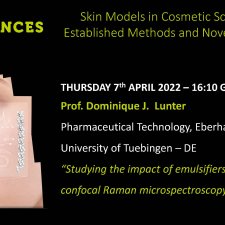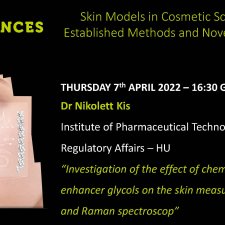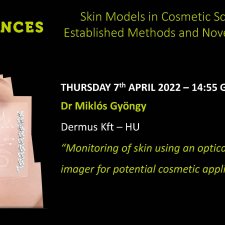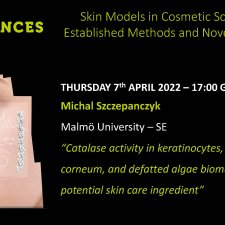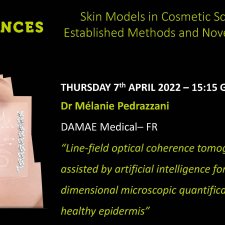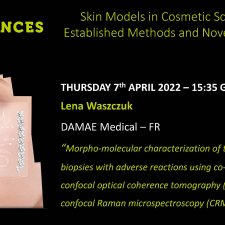Notice
Dr Mais Saleh - Nanostructured Vitamin E Phosphate: Characterizing its percutaneous Penetration into Excised Human Skin and release from cosmetic formulations
- document 1 document 2 document 3
- niveau 1 niveau 2 niveau 3
Descriptif
Co-authors : M.M. SALEH 1, R. ABU HAMDAN 1, W. ALSHAER 2, M. AMARIN 3
1 Department of Pharmaceutics and Pharmaceutical technology, School of Pharmacy, The University of Jordan, Amman 11942, Jordan
2 Cell therapy Center, The University of Jordan, Amman 11942, Jordan
3 Jordan University Hospital, Amman, Jordan
Modern topical sunscreens combine topical antioxidants with physical UV filters to achieve optimal skin protection1–3. α-Tocopherol phosphate (α-TP), a new pro-vitamin E antioxidant, prevents UVA1 induced cell death and scavenges the reactive oxygen species that are produced in skin cells4. The aim of this study is to investigate if α-TP in candidate vehicles can penetrate excised human skin. This study also aims to prepare solid lipid nanoparticles (SLNs) that can act as a physical sunscreen, containing α-TP and evaluate for encapsulation efficiency (EE) and skin deposition.
α-TP was prepared in different candidate formulations; 2% α-TP solution in a 20:20:60% (v/v/v) propylene glycol: ethanol: Tris buffer (0.1 M) vehicle at pH 7.4 (F1), 2% α-TP lotion at pH 6.8 (F2), and 2% α-TP carbopol gel at pH 6.4 (F3). A topical dose of 9 mg/cm2 from the three formulations was applied for 3 h to test the α-TP skin deposition in the stratum corneum (SC) and remained skin (RS) using the stripping method. Furthermore, skin deposition of α-TP from F1 was observed after 3, 6, and 24 hours. For sunscreen formulation, the SLNs are prepared by precipitation method5. The SLNs are evaluated for α-TP encapsulation, particle size, polydispersity index (PDI), zeta potential, and α-TP skin deposition.
The skin deposition studies demonstrated that when α-TP administered in a pH 7.4 vehicle (F1, HD size 10 nm) showed a higher deposition in the SC at 3 hours although it was not statistically significant (31.58 ± 13.19 µg/cm2 vs. 25.36 ± 3.93 µg/cm2 vs. 24.13 ± 10.50 µg/cm2, p > 0.05) and a similar deposition in the RS (4.76 ± 2.45 µg/cm2 vs. 4.49 ± 2.32 µg/cm2 vs. 3.70 ± 3.40 µg/cm2, p > 0.05) compared to the lotion (F2) and gel (F3) formulations, respectively. The skin deposition of α-TP from F1 in SC increase when increasing the application time from 3 h to 24 h (31.58 ± 13.19 µg/cm2 vs. 63.65 ± 13.32 µg/cm2, p = 0.046, one-way ANOVA with Dunnett's multiple comparison tests). This effect was not as pronounced with regards to penetration into RS (4.76 ± 2.45 µg/cm2 vs. 11.83 ± 9.21 µg/cm2 p > 0.05). Finally, α-TP loaded SLNs exhibited a size in the nanoparticulate range (41.81 ± 0.74 nm), PDI of 0.20 ± 0.01, zeta potential of -2.89 ± 1.00 and demonstrated an interesting EE (87.50 ± 17.50%).
The enhanced α-TP penetration into the SC from the vehicle at pH 7.4 when applied for 24 h was due to the formation of nanoaggregates which readily deposited into the SC. The α-TP loaded SLNs were characterized by valid size and good EE. This result confirms the suitability of the sunscreen formulation employed in the present work for further in vitro testing investigation into the role of SLNs in enhancing α-TP penetration through human skin.
1. Young, A. R. et al. Sub-optimal Application of a High SPF Sunscreen Prevents Epider-mal DNA Damage in Vivo. Acta Derm Venereol 98, 880–887 (2018).
2. Wu, Y. et al. Antioxidants add protection to a broad-spectrum sunscreen. Clin. Exp. Dermatol. 36, 178–187 (2011).
3. Matsui, M. S. et al. Non-Sunscreen Photoprotection: Antioxidants Add Value to a Sunscreen. J. Investig. Dermatology Symp. Proc. 14, 56–59 (2009).
4. Saleh, M., Lawrence, K. P. & Young, A. The Photoprotective Properties of α-Tocopherol Phosphate Against Long-Wave UVA1 (385 nm) Radiation in Keratinocytes in Vitro. (2021) doi:10.21203/rs.3.rs-275304/v1.
5. Heurtault, B., Saulnier, P., Pech, B., Proust, J. & Benoit, J. A Novel Phase Inversion-Based Process for the Preparation of Lipid Nanocarriers. Pharm. Res. 19, 875–880 (2002).
Thème
Dans la même collection
-
Dr Julien Chlasta - How’s AFM a fantastic tool in cosmetic research?
Atomic force microscopy (AFM) is a tool for nanoscale analysis-based approach allowing to obtain mechanical information about structures
-
Dr Catherine Grillon - New reconstructed epidermis models closer to skin physiology
Among skin models, reconstructed human epidermis are largely used in cosmetic domain either to evaluate compounds activity or for regulatory tests such as toxicity. They represent a good alternative
-
Dr Franciska Erdo - Studying topical drug delivery in Skin-on-a-chip and by Confocal RAMAN spectros…
Studying skin composition and interaction with topical substances is important both in dermatology and cosmetoscience. Several techniques are utilized and are under development for these purposes.
-
Marek Puskar - Evaluation of serum growth factors in wound healing using a full-thickness in vitro …
Following skin injury, damaged tissue undergoes highly coordinated biological events to restore barrier function involving cross-talk between dermal fibroblasts and epidermal keratinocytes as well as
-
Prof. Dominique J. Lunter - Studying the impact of emulsifiers on SC lipids by confocal Raman micr…
Emulsifiers are widely used in face washes, shower gels, body lotions and many more cosmetic and pharmaceutic products. Some of them are suspected to show irritating effects and to harm the skin
-
Dr Maxim Darvin - Two-photon excited fluorescence lifetime imaging for non-invasive visualization …
Mast cells (MCs) and macrophages (ΜΦs) are important multifunctional immune cells found in all tissues of the body. In the skin, resting and activated MC populations and M1- and M2-polarized ΜΦs are
-
Dr Nikolett Kis - Investigation of the effect of chemical permeation enhancer glycols on the skin m…
Dermal drug delivery is an attractive alternative to conventional drug administration due to its advantages.
-
Dr Miklós Gyöngy - Monitoring of skin using an optical-ultrasound imager for potential cosmetic app…
Optical-ultrasound imaging is a cost-effective method of simultaneously imaging the skin surface and the region under the surface.
-
Michal Szczepanczyk - Catalase activity in keratinocytes, stratum corneum, and defatted algae bioma…
Catalase is one of the most important antioxidative enzymes. Its main function is the decomposition of hydrogen peroxide belonging to the group of reactive oxygen species.
-
Dr Mélanie Pedrazzani - Line-field optical coherence tomography (LC-OCT) assisted by artificial int…
Line-field confocal optical coherence tomography (LC-OCT) is an optical technique based on a combination of confocal microscopy and optical coherence tomography, allowing three-dimensional (3D)
-
Lena Waszczuk - Morpho-molecular characterization of tattooed skin biopsies with adverse reactions …
Line-field confocal optical coherence tomography (LC-OCT) is a non-invasive optical technique for imaging the skin at high resolution (∼ 1 μm), based on a combination of OCT and reflectance confocal
-
Dr Jeyaraj Ponmozhi - Realtime analysis of drug (diffusion, toxicity, would healing, repair, inflam…
Advantages of microfluidics could outnumber the advantages in reconstructed and excised skin samples in certain cases for the study on permeability, toxicity, irritation, corrosion, disease models





